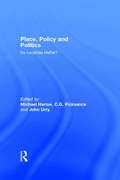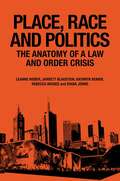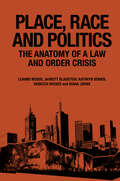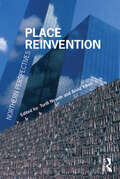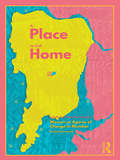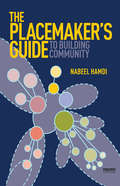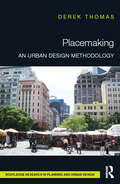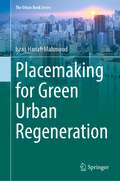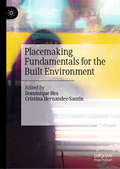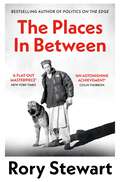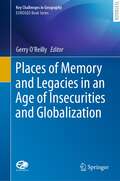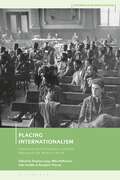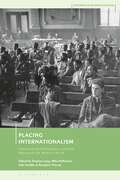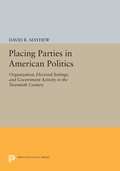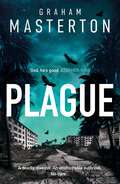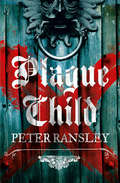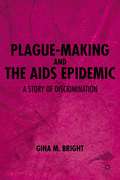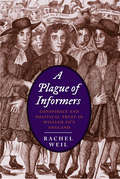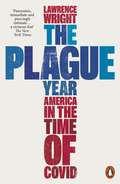- Table View
- List View
Place, Policy and Politics: Do Localities Matter?
by Michael Harloe C. G. Pickvance John UrryThe past ten years have seen local government in the UK facing two major challenges: to survive in the face of Thatcher government hostility, and to adapt to enormously powerful forces of economic restructuring which have also been encouraged by government policies. The key aspects of these changing fortunes of British towns explored in this important new book is the ability of individual localities to exercise any control over their own growth and decline. Place, Policy and Politics examines local political initiatives seeking to influence economic and social development in seven sharply contrasting localities, ranging from the outer council estates of Merseyside to the boom towns of Cheltenham and Swindon. Throughout their analysis, the contributors, drawn from a wide range of social science disciplines, address the vital questions in the debate over local policy initiatives, including: * To what extent are localities able to harness trends in the national and international economy to provide jobs and a better standard of living for their inhabitants? * Why do local authorities vary in their capacity to initiate economic policy? * To what extent do national urban and other policies inhibit or encourage their efforts? * How might central government modify its policies to facilitate the prospering of localities?
Place, Race and Politics: The Anatomy of a Law and Order Crisis
by Leanne Weber Jarrett Blaustein Kathryn Benier Rebecca Wickes Diana JohnsPlace, Race and Politics presents an integrated analysis of the social and political processes that combined to construct a media-driven ‘crisis’ concerning African youth crime in the city of Melbourne, Australia. Combining original research and analysis alongside published sources, the authors carefully dissect the anatomy of a racialized and politicized public discourse and delve into the profound impact of this on African-Australian communities in Melbourne. Drawing on political and media analysis and community-based research, the authors investigate how South Sudanese Australians in Melbourne came to be identified, supposedly, as a unique threat to community safety, the role played by the media, state and federal politics, the policing and perceptions of race in this process, and the physical and emotional impacts on affected communities of the law and order crisis concerning ‘African crime’. While deeply rooted in local conditions, the book resonates with similar examples of the criminalization and othering of racialized communities, the surveillance and exclusion of ‘crimmigrants’, and with popular punitivism and the rise of far-right politics globally in response to deeply felt anxieties about rapid social, economic and cultural change.
Place, Race and Politics: The Anatomy of a Law and Order Crisis
by Leanne Weber Jarrett Blaustein Kathryn Benier Rebecca Wickes Diana JohnsPlace, Race and Politics presents an integrated analysis of the social and political processes that combined to construct a media-driven ‘crisis’ concerning African youth crime in the city of Melbourne, Australia. Combining original research and analysis alongside published sources, the authors carefully dissect the anatomy of a racialized and politicized public discourse and delve into the profound impact of this on African-Australian communities in Melbourne. Drawing on political and media analysis and community-based research, the authors investigate how South Sudanese Australians in Melbourne came to be identified, supposedly, as a unique threat to community safety, the role played by the media, state and federal politics, the policing and perceptions of race in this process, and the physical and emotional impacts on affected communities of the law and order crisis concerning ‘African crime’. While deeply rooted in local conditions, the book resonates with similar examples of the criminalization and othering of racialized communities, the surveillance and exclusion of ‘crimmigrants’, and with popular punitivism and the rise of far-right politics globally in response to deeply felt anxieties about rapid social, economic and cultural change.
Place Reinvention: Northern Perspectives
by Arvid VikenThrough an interdisciplinary range of case studies from across the Northern rim of Europe, this volume shows how place reinvention as a concept affects not only global cities but also marginal regions. Linking place reinvention to the economic, the symbolic and the political production of space, the volume puts forward insights into how 'marginal areas' understand their role in the global competition between places and regions through their branding strategies, playing with representations of the unique and the ordinary, urban and rural, reindustrialization and cultural economy. It also shows how and why some places seem to retain and strengthen their uniqueness, whilst others are losing their local distinctiveness in the struggle to survive.
Place Reinvention: Northern Perspectives
by Arvid VikenThrough an interdisciplinary range of case studies from across the Northern rim of Europe, this volume shows how place reinvention as a concept affects not only global cities but also marginal regions. Linking place reinvention to the economic, the symbolic and the political production of space, the volume puts forward insights into how 'marginal areas' understand their role in the global competition between places and regions through their branding strategies, playing with representations of the unique and the ordinary, urban and rural, reindustrialization and cultural economy. It also shows how and why some places seem to retain and strengthen their uniqueness, whilst others are losing their local distinctiveness in the struggle to survive.
A Place to Call Home: Women as Agents of Change in Mumbai
by Ramya RamanathAny city is a product of politics and economics, organizations and people. Yet, the life experiences of women uprooted from its poorest quarters seldom inform urban resettlement plans. In this ethnographic field study, Ramya Ramanath, Associate Professor at DePaul University, examines the lives of women displaced by slum clearance and relocated to the largest slum resettlement site in Asia. Through conversations with diverse women of different ages, levels of education, types of employment, marital status, ethnicity, caste, religion, and household make-up, Ramanath recounts how women negotiate a drastic change in environment, from makeshift housing in a park slum to ownership of a high-rise apartment in a posh Mumbai suburb. Each phase of their city lives reflects how women initiate change and disseminate a vision valuable to planners intent on urban and residential transformations. Ramanath urges the concerted engagement of residents in design, development, and evaluation of place-making processes in cities and within their own neighborhoods especially. This book will interest scholars of public policy, women and gender studies, South Asian studies, and urban planning.
A Place to Call Home: Women as Agents of Change in Mumbai
by Ramya RamanathAny city is a product of politics and economics, organizations and people. Yet, the life experiences of women uprooted from its poorest quarters seldom inform urban resettlement plans. In this ethnographic field study, Ramya Ramanath, Associate Professor at DePaul University, examines the lives of women displaced by slum clearance and relocated to the largest slum resettlement site in Asia. Through conversations with diverse women of different ages, levels of education, types of employment, marital status, ethnicity, caste, religion, and household make-up, Ramanath recounts how women negotiate a drastic change in environment, from makeshift housing in a park slum to ownership of a high-rise apartment in a posh Mumbai suburb. Each phase of their city lives reflects how women initiate change and disseminate a vision valuable to planners intent on urban and residential transformations. Ramanath urges the concerted engagement of residents in design, development, and evaluation of place-making processes in cities and within their own neighborhoods especially. This book will interest scholars of public policy, women and gender studies, South Asian studies, and urban planning.
The Placemaker's Guide to Building Community
by Nabeel HamdiFrom the author of Small Change comes this engaging guide to placemaking, packed with practical skills and tools that architects, planners, urban designers and other built environment specialists need in order to engage effectively with development work in any context. Drawing on four decades of practical and teaching experience, the author offers fresh insight into the complexities faced by practitioners when working to improve the communities, lives and livelihoods of people the world over. The book shows how these complexities are a context for, rather than a barrier to, creative work. The book also critiques the single vision top down approach to design and planning. Using examples of successful professional practice across Europe, the US, Africa, Latin America and post-tsunami Asia, the author demonstrates how good policy can derive from good practices when reasoned backwards, as well as how plans can emerge in practice without a preponderance of planning. Reasoning backwards is shown to be a more effective and inclusive way of planning forwards with significant improvements to the quality of process and place. The book also offers a variety of methods and tools for analyzing the issues, engaging with communities and other stakeholders for design and settlement planning and for improving the skills of all involved in placemaking. Ultimately the book serves as an inspiring guide, and a distillation of decades of practical wisdom and experience. The resulting practical handbook is for all those involved in doing, learning and teaching placemaking and urban development world-wide.
The Placemaker's Guide to Building Community (Earthscan Tools For Community Planning Ser.)
by Nabeel HamdiFrom the author of Small Change comes this engaging guide to placemaking, packed with practical skills and tools that architects, planners, urban designers and other built environment specialists need in order to engage effectively with development work in any context. Drawing on four decades of practical and teaching experience, the author offers fresh insight into the complexities faced by practitioners when working to improve the communities, lives and livelihoods of people the world over. The book shows how these complexities are a context for, rather than a barrier to, creative work. The book also critiques the single vision top down approach to design and planning. Using examples of successful professional practice across Europe, the US, Africa, Latin America and post-tsunami Asia, the author demonstrates how good policy can derive from good practices when reasoned backwards, as well as how plans can emerge in practice without a preponderance of planning. Reasoning backwards is shown to be a more effective and inclusive way of planning forwards with significant improvements to the quality of process and place. The book also offers a variety of methods and tools for analyzing the issues, engaging with communities and other stakeholders for design and settlement planning and for improving the skills of all involved in placemaking. Ultimately the book serves as an inspiring guide, and a distillation of decades of practical wisdom and experience. The resulting practical handbook is for all those involved in doing, learning and teaching placemaking and urban development world-wide.
Placemaking: An Urban Design Methodology
by Derek ThomasEnd-users provide the most valuable perspective and insights into how public social space should function. Much of the failure of urban settings can be related to over-structured urban environments which deterministically prescribe usage, constraining instead of enabling socio-spatial performance. Planning decisions by specialists should be made with the participation of the end-user to minimise uncertainty as far as possible, creating enabling environments. Placemaking: An Urban Design Methodology presents a methodology that evaluates the preferences of urban dwellers and synthesises these with the planning specialist’s expertise, better representing all views. Author Derek Thomas integrates the Sondheim Methodology with means to understanding cultural clues to create a matrix methodology that links planning primers with planning actions. A unique new tool for community planners, this book emphasises the importance of the community while taking into account the expertise of the planner in creating public spaces.
Placemaking: An Urban Design Methodology
by Derek ThomasEnd-users provide the most valuable perspective and insights into how public social space should function. Much of the failure of urban settings can be related to over-structured urban environments which deterministically prescribe usage, constraining instead of enabling socio-spatial performance. Planning decisions by specialists should be made with the participation of the end-user to minimise uncertainty as far as possible, creating enabling environments. Placemaking: An Urban Design Methodology presents a methodology that evaluates the preferences of urban dwellers and synthesises these with the planning specialist’s expertise, better representing all views. Author Derek Thomas integrates the Sondheim Methodology with means to understanding cultural clues to create a matrix methodology that links planning primers with planning actions. A unique new tool for community planners, this book emphasises the importance of the community while taking into account the expertise of the planner in creating public spaces.
Placemaking for Green Urban Regeneration (The Urban Book Series)
by Israa Hanafi MahmoudThis book investigates the dynamics and the role of green urban regeneration using nature-based solutions (NBS) in contributing to the cultural aspects of public spaces. In the first part of the book, insights on analytical methods, planning strategies and shared governance examples are given, as well as, an assessment tool, namely public space index (PSI), is given for successfully measuring sociability impact while using a placemaking approach to green urban regeneration processes. In the second part, the case study (Rose Kennedy Greenway of Boston, MA, USA) has been extensively researched during many years of observations and analysis which gives a realistic taste of the implementation of the proposed PSI. The book’s last part reflects on PSI to measure its adaptability and replicability in other contexts, whereas NBS are playing a major role in physical and spatial green urban regeneration in current cities contexts’.
Placemaking Fundamentals for the Built Environment
by Dominique Hes Cristina Hernandez-SantinThis book is for all those actively working in the built environment. It presents the latest theory and practice of engaging with stakeholders to co-design, develop and manage thriving places. It starts from the importance of integrating design of nature into practice built on a foundation of First Nations understanding of place. The art of engagement of community, government and the development industry is discussed with reference to case studies and best practice techniques. The book then focuses on the critical role placemaking has in supporting resilience and adaptability of communities and looks at issues of leadership and governance. Building on these steps for placemaking, the last parts of the book address economics, evaluation, digital and art based tools and approaches to support projects that aim to create an engaged, contributive, collaborative and active citizen.
Placeness and the Performative Production of Space
by Aleksandar Sasha Dundjerovic María José SánchezHow can performance create and transform places of urban renewal and regeneration? What does performance contribute to the creation of community? These are some of the questions addressed in this study of the relationship of performance to urban space. Marrying theory with a series of international case studies of performance practice and interviews with practitioners, this interdisciplinary study examines how space is performatively produced to create a sense of 'placeness'. Offering multiple perspectives on space and place, this book investigates the connections between space and the construction of social and cultural narratives. It focuses on the multiple ways performative actions produce space, including theatre, installations, site-specific work, visual arts and digital performance. Combining interdisciplinary approaches to contemporary performance, architecture and digital media studies, this study builds on a clear theoretical framework that draws on the work of Walter Benjamin, Michel Foucault, Henri Lefevre, Richard Schechner, Hans-Thies Lehmann, Lev Manovich and Slavoj Žižek. It offers themed sections comprising theory, studies of practice and interviews with practitioners. Case studies include site-specific work by Catalan collective La Fura Dels Baus, Barcelona, Spain, the Prague Quadrennial, community engagement in Praça Roosevelt in Sao Paulo, Brazil, the Portland Inn Project in Stoke-on-Trent, UK, Campo de la Cebada in Madrid, Spain, and digital spaces created by artists in India and Bosnia and Herzegovina.
Placeness and the Performative Production of Space
by Aleksandar Sasha Dundjerovic María José SánchezHow can performance create and transform places of urban renewal and regeneration? What does performance contribute to the creation of community? These are some of the questions addressed in this study of the relationship of performance to urban space. Marrying theory with a series of international case studies of performance practice and interviews with practitioners, this interdisciplinary study examines how space is performatively produced to create a sense of 'placeness'. Offering multiple perspectives on space and place, this book investigates the connections between space and the construction of social and cultural narratives. It focuses on the multiple ways performative actions produce space, including theatre, installations, site-specific work, visual arts and digital performance. Combining interdisciplinary approaches to contemporary performance, architecture and digital media studies, this study builds on a clear theoretical framework that draws on the work of Walter Benjamin, Michel Foucault, Henri Lefevre, Richard Schechner, Hans-Thies Lehmann, Lev Manovich and Slavoj Žižek. It offers themed sections comprising theory, studies of practice and interviews with practitioners. Case studies include site-specific work by Catalan collective La Fura Dels Baus, Barcelona, Spain, the Prague Quadrennial, community engagement in Praça Roosevelt in Sao Paulo, Brazil, the Portland Inn Project in Stoke-on-Trent, UK, Campo de la Cebada in Madrid, Spain, and digital spaces created by artists in India and Bosnia and Herzegovina.
The Places In Between: A vivid account of a death-defying walk across war-torn Afghanistan
by Rory StewartWinner of the RSL Ondaatje PrizeShortlisted for the Guardian First Book Award‘A striding, glorious book . . . A flat-out masterpiece’ The New York Times Book ReviewCaught between hostile nations, warring factions and competing ideologies, Afghanistan was in turmoil following the US invasion. Travelling entirely on foot and following the inaccessible mountainous route once taken by the Mughal emperor Babur the Great, Rory Stewart was nearly defeated by the extreme, hostile conditions.Only with the help of an unexpected companion, and the generosity of the people he met on the way, did he survive to report back on his journey with unique insight on a region closed to the world by twenty-four years of war.‘This evocative book feels like a long-lost relic of the great age of exploration’ The Guardian
Places of Memory and Legacies in an Age of Insecurities and Globalization (Key Challenges in Geography)
by Gerry O’ReillyIn this book, practitioners and students discover perspectives on landscape, place, heritage, memory, emotions and geopolitics intertwined in evolving citizenship and democratization debates. This volume shows how memorialization can contribute to wider inclusive interpretations of history, tourism and human rights promoted by the European Project. It's geographies of memories can foster cooperation as witnessed throughout Europe during the 2014-18 WWI commemorations. Due to new world orders, geopolitical reconfigurations and ideals that emerged after 1918, many countries ranging from the Baltic and Russia to the Balkans, Turkey and Greece, eastern and central Europe to Ireland are continuing with commemorations regarding their specific memories in the wider Europe. Shared memorial spaces can act in post conflict areas as sites of reconciliation; nonetheless `the peace' cannot be taken for granted with insecurities, globalization, and nationalisms in the USA and Russia; the UK's Brexit stress and populist movements in Western Europe, Visegrád and Balkan countries. Citizen-fatigue is reflected in socio-political malaise mirrored in France's Yellow Vest movement and elsewhere. Empathy with other peoples' places of memory can assist citizens learn from the past. Memory sites promoted by the EU, Council of Europe and UNESCO may tend to homogenize local memories; nevertheless, they act as vectors in memorialization, stimulating debate and re-evaluating narratives. This textbook combines geographical, inter-cultural and inter-disciplinary approaches and perspectives on spaces of memory by a range of authors from different countries and traditions offers the reader diverse and holistic perspectives on cultural geography, dynamic geopolitics, globalization and citizenship.
Placing Internationalism: International Conferences and the Making of the Modern World (Histories of Internationalism)
by Stephen Legg Mike Heffernan Jake Hodder Benjamin ThorpeExploring how modern internationalism emerged as a negotiated process through international conferences, this edited collection studies the spaces and networks through which states, civil society institutions and anti-colonial political networks used these events to realise their visions of the international.Taking an interdisciplinary approach, contributors explore the spatial paradox of two fundamental features of modern internationalism. First, internationalism demanded the overcoming of space, transcending the nation-state in search of the shared interests of humankind. Second, internationalism was geographically contingent on the places in which people came together to conceive and enact their internationalist ideas. From Paris 1919 to Bandung 1955 and beyond, this book explores international conferences as the sites in which different forms of internationalism assumed material and social form. While international 'permanent institutions' such as the League of Nations, UN and Institute of Pacific Relations constantly negotiated national and imperial politics, lesser-resourced political networks also used international conferences to forward their more radical demands.Taken together these conferences radically expand our conception of where and how modern internationalism emerged, and make the case for focusing on internationalism in a contemporary moment when its merits are being called into question.
Placing Internationalism: International Conferences and the Making of the Modern World (Histories of Internationalism)
by Stephen Legg, Mike Heffernan, Jake Hodder and Benjamin J. ThorpeExploring how modern internationalism emerged as a negotiated process through international conferences, this edited collection studies the spaces and networks through which states, civil society institutions and anti-colonial political networks used these events to realise their visions of the international.Taking an interdisciplinary approach, contributors explore the spatial paradox of two fundamental features of modern internationalism. First, internationalism demanded the overcoming of space, transcending the nation-state in search of the shared interests of humankind. Second, internationalism was geographically contingent on the places in which people came together to conceive and enact their internationalist ideas. From Paris 1919 to Bandung 1955 and beyond, this book explores international conferences as the sites in which different forms of internationalism assumed material and social form. While international 'permanent institutions' such as the League of Nations, UN and Institute of Pacific Relations constantly negotiated national and imperial politics, lesser-resourced political networks also used international conferences to forward their more radical demands.Taken together these conferences radically expand our conception of where and how modern internationalism emerged, and make the case for focusing on internationalism in a contemporary moment when its merits are being called into question.
Placing Parties in American Politics: Organization, Electoral Settings, and Government Activity in the Twentieth Century
by David R. MayhewThis work on the structure of American parties combines the breadth that has been characteristic of voter analyses and the richness found in case studies of local party organizations.Originally published in 1986.The Princeton Legacy Library uses the latest print-on-demand technology to again make available previously out-of-print books from the distinguished backlist of Princeton University Press. These editions preserve the original texts of these important books while presenting them in durable paperback and hardcover editions. The goal of the Princeton Legacy Library is to vastly increase access to the rich scholarly heritage found in the thousands of books published by Princeton University Press since its founding in 1905.
Plague: A Gripping Suspense Thriller About An Incurable Outbreak In Miami
by Graham Masterton'One of Britain's finest horror writers' DAILY MAIL A deadly disease. No cure. Anyone who leaves the plague-zone must be shot. At first the rules were simple: quarantine the city, and let the plague die. So men and women closed their doors, and lived in lockdown, fighting for survival against a disease as contagious and destructive as the Black Death. A disease for which there was no known cure.But the plague did not die. And so, at lunchtime on a Friday afternoon, the President announces the new rules. Every American should take up arms to protect the disease-free zones. Anyone attempting to leave the plague-zone must be shot.A gripping suspense thriller about an outbreak of plague in the USA, this is perfect for fans of Dean Koontz or Stephen King. 'One of the most original and frightening storytellers of our time' PETER JAMES 'A true master of horror' JAMES HERBERT 'God, he's good' STEPHEN KING
Plague Child
by Peter RansleyThe first instalment of a captivating trilogy set against the backdrop of the English Civil War.
Plague-Making and the AIDS Epidemic: A Story Of Discrimination
by G. BrightThis book explores how the cultural process of making any disease a "plague" results in discrimination against certain groups, as it has for those with AIDS in America. Gina M. Bright here captures the discrimination produced by plague-making in her analysis and her portraits of the people she has cared for with AIDS over the past quarter-century.
A Plague of Informers: Conspiracy and Political Trust in William III's England (The Lewis Walpole Series in Eighteenth-Century Culture and History)
by Rachel WeilStories of plots, sham plots, and the citizen-informers who discovered them are at the center of Rachel Weil's compelling study of the turbulent decade following the Revolution of 1688. Most studies of the Glorious Revolution focus on its causes or long-term effects, but Weil instead zeroes in on the early years when the survival of the new regime was in doubt. By encouraging informers, imposing loyalty oaths, suspending habeas corpus, and delaying the long-promised reform of treason trial procedure, the Williamite regime protected itself from enemies and cemented its bonds with supporters, but also put its own credibility at risk.
The Plague Year: America in the Time of Covid
by Lawrence WrightJust as Lawrence Wright's The Looming Tower became the defining account of our century's first devastating event, 9/11, so The Plague Year will become the defining account of the second. The story starts with the initial moments of Covid's appearance in Wuhan and ends with Joseph Biden's inauguration in an America ravaged by well over 400,000 deaths - a mortality already some ten times worse than US combat deaths in the entire Vietnam War.This is an anguished, furious memorial to a year in which all of America's great strengths - its scientific knowledge, its great civic and intellectual institutions, its spirit of voluntarism and community - were brought low, not by a terrifying new illness alone, but by political incompetence and cynicism on a scale for which there has been no precedent. With insight, sympathy, clarity and rage, The Plague Year allows the reader to see the unfolding of this great tragedy, talking with individuals on the front line, bringing together many moving and surprising stories and painting a devastating picture of a country literally and fatally misled.
